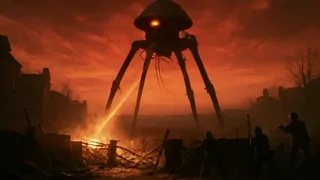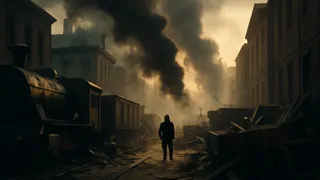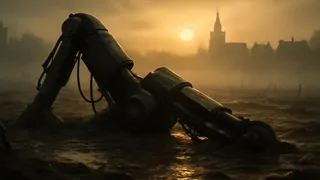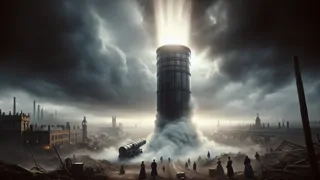Introduction
Dawn broke over the rolling fields of Surrey with a sense of uneasy calm, as if nature itself hesitated to greet the day. Wisps of mist curled through hedgerows and kissed the dew-laden grass, while distant church bells tolled their early hour across the villages. Yet there was unrest in the air: a low humming so soft it eluded immediate notice, an undercurrent of vibration that quickened the pulse of any curious soul brave enough to linger outside. Farmers paused mid–plough, household servants leaned silently from windows, and even the birds fell quiet in their branches. By midday, those same fields fell silent under a different spectacle, as a metal cylinder — scorched and cratered — emerged from earth with a hiss of steam and sulfur. It stood alone atop the heath, an alien testament to power beyond mortal reckoning. Word spread like wildfire: telescopes glimpsed strange articulations across the sand, and men with wounded eyes described tentacles and glowing eyes. London soon awoke to reports of heat rays cutting swathes through carriages and routs of panicked horses. In laboratories and drawing rooms, masters of science discarded theory to fashion desperate plans of defense. Amid collapsing bridges and charred rooftops, ordinary folk found courage they never knew they possessed. In the forging of alliances between aristocrat and laborer, patriot and poet, the first spark of hope ignited — a hope that survival might depend on more than sheer strength, but on ingenuity, sacrifice and an unbreakable resolve to reclaim the world.
Chapter 1: The Falling Star
The earth trembled when the first cylinder smashed into the dusty expanse of the Surrey heath. Locals rushed toward the smoking crater, curiosity entwined with dread. Witnesses spoke of a metallic husk older than any known craft, its surface pockmarked by scorching heat and etched with Martian symbols that defied comprehension. Flames leapt from ruptured pipes, and the air filled with a harsh whine that seemed to gnaw at the mind itself. As the crowd pressed forward, a sudden hiss raced across the ground. Terrified cries split the silence when hooked limbs erupted in a whip of movement. Witnesses scattered as a brutal beam of orange flame seared the horizon, igniting dry reeds and reducing thatched roofs to cinders before retreating like a malevolent sun.

News of villages laid waste traveled swiftly by telegraph and mail coach, bearing tales of invaders who moved upon towering tripods. London’s elite mobilized scientific minds: engineers, astronomers, chemists — all frantically debating strategies to counter an enemy armed with gravity weapons and chilling intelligence. Across drawing rooms lit by gas lamps, debates flared. Should they develop explosive charges to topple the machines’ slender legs? Or study the advanced optics glimpsed through shattered lenses? Meanwhile, ordinary citizens armed themselves with rifles and courage, forming ragged militias along country roads where the Martians advanced in slow, unstoppable columns. There, under the shadow of broken hedgerows and oaks rendered brittle by heat ray blasts, men learned to trust one another beyond rank or station.
As the invasion pressed toward the capital, roared trains carried refugees in terrified heaps toward safer ground. Mothers shielded children from the sky’s unnatural glare, and doctors triaged scorched survivors in makeshift hospitals beneath railway arches. Rumors swirled of secret retreats where the Martians studied human technology, of subterranean lairs beneath empty mansions. In the heart of London, St. Paul’s bells tolled and government couriers raced through roundabouts of panicked humanity. Yet even amid devastation, small miracles emerged: a team of telegraph operators successfully intercepted Martian signals and deciphered fragments of their language, hinting at vulnerabilities in their communications network. Rumbling engines of war were repurposed to shield supply lines. Night patrols illuminated the looming silhouettes against burning ruins, forging bonds between all who fought for the survival of an imperiled world.
By week’s end, the once-verdant countryside lay charred, a battlefield where scorched earth tactics and relentless heat rays had reduced homes to ash and shattered centuries of rural tranquility. Church steeples collapsed under tripod shadows, and the Thames ran dark with debris. Yet in the hush that followed every assault, survivors edged forward to reconstruct plans for resistance. They scavenged alien alloys, studied the hissing tubes excavated from Martian wreckage, and experimented with makeshift armor crafted from railway scrap. Soldiers drilled behind ragged trenches. Volunteers pressed crimson bandages on burned limbs. And above it all, the silent promise of vengeance burned brightest in every human heart — a promise that would lead to sacrifices as great as any storm of Martian wrath.
Chapter 2: Siege of the Metropolis
London braced for the Siege. Barricades of overturned carts and broken furniture crisscrossed suburban streets, while detachments of Home Guards kept watch with tremulous discipline. The city’s grand museums and Gothic cathedrals became hospital wards and munitions factories. Engineers huddled over soot-blackened workbenches, modifying field artillery to deliver explosive shells into the bronze plating of Martian machines. Chemistry professors produced acid shells to dissolve joints of the walking tripods. Local inventors tested electrified nets in Hyde Park and deployed pneumatic cannons along the embankments. Yet the Martians struck first, their heat rays lancing streets like molten spears, setting warehouses aflame and cracking stonework with explosive force.

Residents bolted behind shuttered windows as the thunder of tripod feet grew closer. Smoke curled in coils over Westminster’s spires, and the roar of panic spread faster than any tidal wave. Where soldiers fired volleys of rifles, the bullets splintered against an alien armor that glowed with an otherworldly sheen. In the suffocating fog of chemical retaliation, men stumbled upon new terrors: black vapor tanks released choking clouds that crept beneath doors and suffocated barricaded families. Still, hope persisted in small victories — a single artillery battery might cripple a leg of a tripod before it could turn its deadly beam, forcing the creature to collapse with a tortured groan.
Desperate measures unfolded in the heart of Whitehall. Royal engineers rigged telegraph poles with electrified cables, hoping to fry Martian circuits. Telegraph operators fought to maintain communications between neighborhoods as they rerouted messages through secret channels. Meanwhile, the Navy readied the Thames for a final line of defense, deploying torpedo boats to harass any invader attempting a crossing. The city’s clergy tended to the wounded in shadowed crypts, their hymns echoing through stained glass as a reminder of faith under fire. And all the while, civilians raised supplies for those on the front—bread, blankets, bandages—united by a will to endure.
When the invaders finally breached Southwark’s outer defenses, they found smoke-drenched streets lined with improvised mines and blazing barricades. Infantry clung to rooftops, hurling grenades beneath tripod limbs, seeking any weakness in the invaders’ stride. In one dramatic moment, a lone gun crew discharged an experimental mortar that shattered the center of a heat-ray emitter, blinding the Martian craft and buying precious time for a counterattack. That skirmish, captured in tattered newspaper broadsheets, became a clarion call across the empire: humanity could fight back. From the battered dockyards to the broken plazas, ordinary hands scrawled the same message on walls and pamphlets—resist, survive, reclaim.
Chapter 3: Nature’s Redemption
After months of brutal conflict, the invaders pressed inland toward the chalk cliffs, their tripods leaving deep gouges in fields once golden with grain. With spring rains came a surprising ally: the earth itself. Pools of stagnant water formed in the crater fields, teeming with bacteria against which Martian biochemistry had not been tested. Herds of livestock, driven from pastures by the fighting, grazed near the cylinders and fell victim to unseen spores. Soldiers and scientists alike watched in awe as the first tripod succumbed, its joints seized and mechanical legs buckling under the weight of alien metal.

Government laboratories at Cambridge pivoted toward bacteriology, racing to identify the pathogens that could cripple the invaders without harming human life. Journal entries recorded both triumph and frustration — cultures that thrived in nutrient broth yet died on contact with Martian alloy, inoculations tested on captured Martian instruments rather than living suspects. Meanwhile, reconnaissance parties ventured deeper into broken villages to retrieve fallen tentacles and warped panels for study. Past the ruins of Hampshire and the shattered cathedrals of Canterbury, evidence mounted that this invisible army might indeed carry a fatal weakness.
As tales of dying tripods filtered back to London, morale surged. Crowds gathered each evening to read bulletins posted on church doors, marveling at reports of Martian retreat. Storytellers in smoky taverns recounted the bizarre horror of crimson pools beneath fallen war machines, while children—no longer trembling—scrawled cartoons of triumphant bacteria battling oversized limbs. Trenches were abandoned as counteroffensives formed by newly recovered troops moved into the heath, dragging leftover cylinders on improvised sleds to laboratories. The ragged banners of victory fluttered above shafts of blood-orange sunset, a contrast to the alien glow that once drowned every horizon.
In a final, stirring chapter, scientists released a concentrated mist of airborne spores across the still battleground fields. Within hours, the remaining tripods collapsed in convulsions, their metal shells corroding from within. The skies, once streaked with the eerie flare of heat rays, cleared to reveal familiar constellations. The survivors—exhausted, wounded but unbroken—streamed from hideouts to reclaim roads littered with twisted wreckage. City and countryside rose together in cheers that echoed off battered walls and shattered steeples. The battle for Earth had cost countless lives and forever altered the fabric of civilization, but in the end, nature’s smallest creatures became humanity’s greatest hope.
Conclusion
When the last burning embers of the Martian onslaught faded, England—and indeed the world—stood forever changed. Amid smoldering ruins and twisted steel, humanity discovered both fragility and extraordinary resilience. The elegant gaslit streets would one day bustle again with horse-drawn carriages and children’s laughter, but the scars of war remained etched in memory and in crystal formations on battered metal. Scientists catalogued the extraterrestrial alloys and microbes that had wrought both terror and salvation. Governments forged new alliances, sharing discoveries that could defend against any threat from the stars. In parlors and public squares, the hymn of unity replaced the war cry, and every survivor carried a tale of courage, loss and redemption. Though the Martians had come with superior technology and ruthless intent, they overlooked the power of adversity and the unbreakable bond that forms when humankind stands together. From the ashes rose a renewed faith in progress, tempered by humility, and the conviction that Earth’s defenders would forever be watchful of the night sky—ready for whatever wonders or dangers might next slip through the silent veil of the heavens.


















